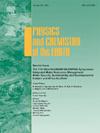地聚合物与废铸造砂在稳定石煤粘土路基中的协同作用
IF 4.1
3区 地球科学
Q2 GEOSCIENCES, MULTIDISCIPLINARY
引用次数: 0
摘要
在道路路基稳定的背景下,本研究探索了地聚合物(GP)粘结剂与废铸造砂(WFS)作为化学稳定添加剂的创新应用。目的是提高在印度卡纳塔克邦沿海地区发现的石质粘土(shedi土)的工程性能。该研究从之前对该地区的石质和红土的研究中获得灵感,考虑到它们独特的挑战和脆弱性。研究了GP合成矿渣和粉煤灰作为整体粘结剂前驱体的有效性。硅酸钠-氢氧化钠混合物水溶液作为化学活化剂,促进了地聚合过程。这一过程包括GP引起的土壤基质胶结和化学变化,以及WFS的机械稳定。该研究彻底检查并阐明了增强的压实特性、无侧限抗压强度(UCS)和加州承载比(CBR)值。通过标准普罗克特试验,确定最佳GP用量为na20与黏合剂比为3.0%。此外,使用WFS的试验表明,15%的WFS可使压实密度提高30.65%,同时UCS和CBR值也有显著提高。此外,该研究将其见解扩展到与印度标准保持一致的低体积柔性路面组成设计。对选定的稳定型和未稳定型岩质粘土的性能差异进行了比较分析。耐久性研究,包括延长强度(UCS, CBR)测试、干湿重复和冻融循环,以获得对开发的稳定技术的信心。扫描电镜(SEM)细观结构分析清楚地阐明了GP-WFS稳定泥煤粘土的机理。总的来说,在GP生产中加入炉渣和粉煤灰,在土壤稳定中加入WFS,显示了其可持续的属性,与全球在路面施工实践和资源优化方面的环保发展相一致。本文章由计算机程序翻译,如有差异,请以英文原文为准。
Synergy of geopolymer and waste foundry sand in stabilizing lithomargic clay subgrades
In the context of road subgrade stabilization, this research explores the innovative application of geopolymer (GP) binder with Waste Foundry Sand (WFS) as chemical stabilizing additives. The aim is to enhance the engineering properties of lithomargic clay (shedi soil) found in the coastal Karnataka region of India. The study draws inspiration from prior studies on lithomargic and lateritic soil in the region, taking into account their unique challenges and vulnerabilities. The investigation focuses on the effectiveness of GP, which synthesizes slag and fly ash as integral binder precursors. The geopolymerization process is facilitated by an aqueous solution of sodium silicate-sodium hydroxide mix, serving as the chemical activating agent. This process involves cementation and chemical alterations within the soil matrix induced by GP, combined with mechanical stabilization using WFS. The study thoroughly examines and elucidates the enhanced compaction properties, Unconfined Compressive Strength (UCS), and California Bearing Ratio (CBR) values. Through Standard Proctor trials, the optimal GP dosage was determined to be with a Na2O-to-binder ratio of 3.0 %. Additionally, trials with WFS showed that 15 % of WFS resulted in a 30.65 % improvement in compacted density, along with substantial enhancements in UCS and CBR values. Furthermore, the study extends its insights into low-volume flexible pavement composition design, aligning with Indian standards. It presents a comparative analysis of performance disparities between selected stabilized and un-stabilized lithomargic clay. Durability studies, including prolonged strength (UCS, CBR) tests, wetting-drying repetitions, and freeze-thaw cycles, were conducted to gain confidence in the developed stabilization technique. Micro-structural analysis using scanning electron microscopy (SEM) clearly elucidated the mechanism by which GP-WFS stabilizes lithomargic clay. Overall, the incorporation of furnace slag, fly ash in GP production, and the inclusion of WFS in soil stabilization showcase its sustainable attributes, aligning with global efforts towards eco-friendly developments in pavement construction practices and resource optimization.
求助全文
通过发布文献求助,成功后即可免费获取论文全文。
去求助
来源期刊

Physics and Chemistry of the Earth
地学-地球科学综合
CiteScore
5.40
自引率
2.70%
发文量
176
审稿时长
31.6 weeks
期刊介绍:
Physics and Chemistry of the Earth is an international interdisciplinary journal for the rapid publication of collections of refereed communications in separate thematic issues, either stemming from scientific meetings, or, especially compiled for the occasion. There is no restriction on the length of articles published in the journal. Physics and Chemistry of the Earth incorporates the separate Parts A, B and C which existed until the end of 2001.
Please note: the Editors are unable to consider submissions that are not invited or linked to a thematic issue. Please do not submit unsolicited papers.
The journal covers the following subject areas:
-Solid Earth and Geodesy:
(geology, geochemistry, tectonophysics, seismology, volcanology, palaeomagnetism and rock magnetism, electromagnetism and potential fields, marine and environmental geosciences as well as geodesy).
-Hydrology, Oceans and Atmosphere:
(hydrology and water resources research, engineering and management, oceanography and oceanic chemistry, shelf, sea, lake and river sciences, meteorology and atmospheric sciences incl. chemistry as well as climatology and glaciology).
-Solar-Terrestrial and Planetary Science:
(solar, heliospheric and solar-planetary sciences, geology, geophysics and atmospheric sciences of planets, satellites and small bodies as well as cosmochemistry and exobiology).
 求助内容:
求助内容: 应助结果提醒方式:
应助结果提醒方式:


